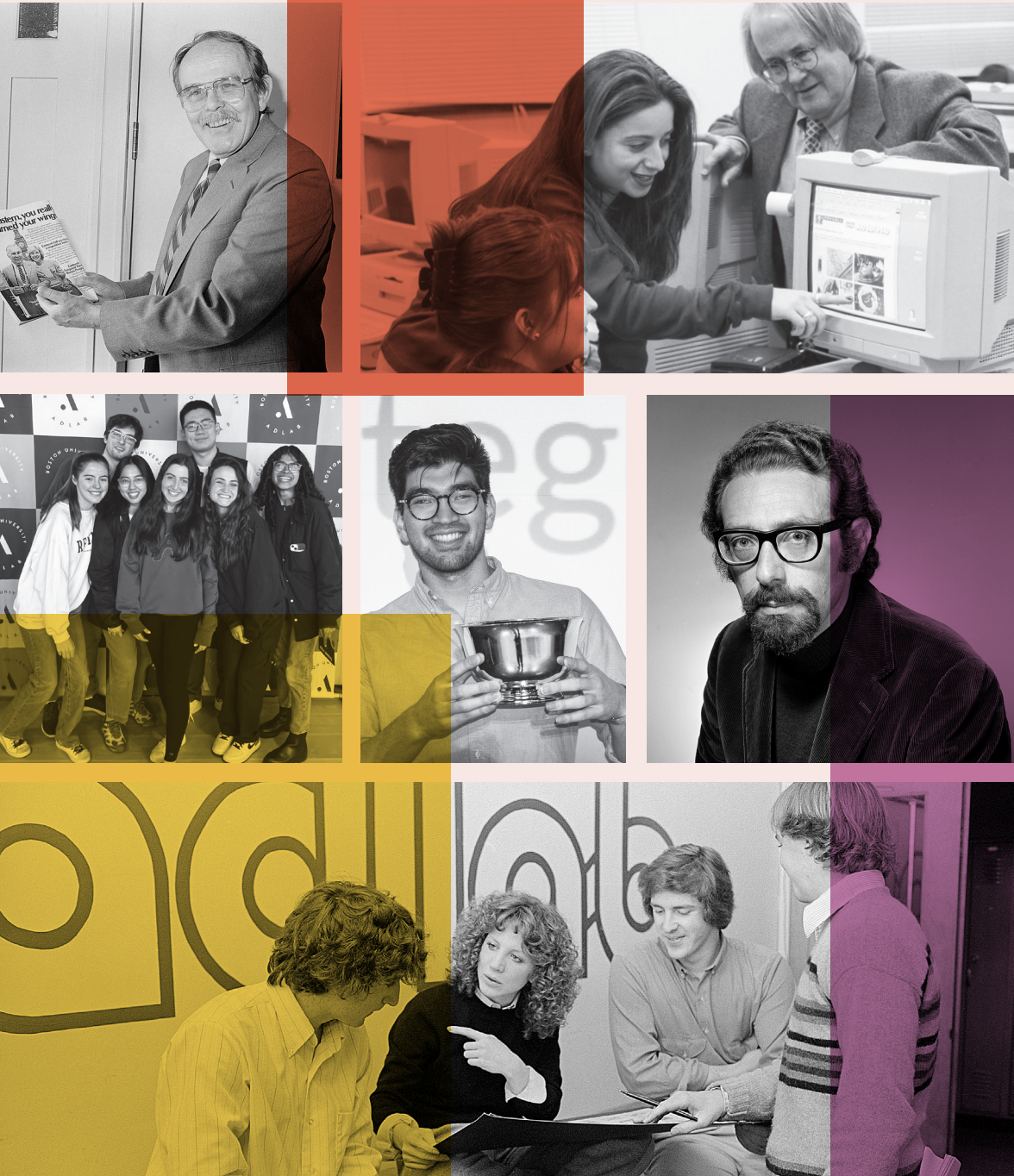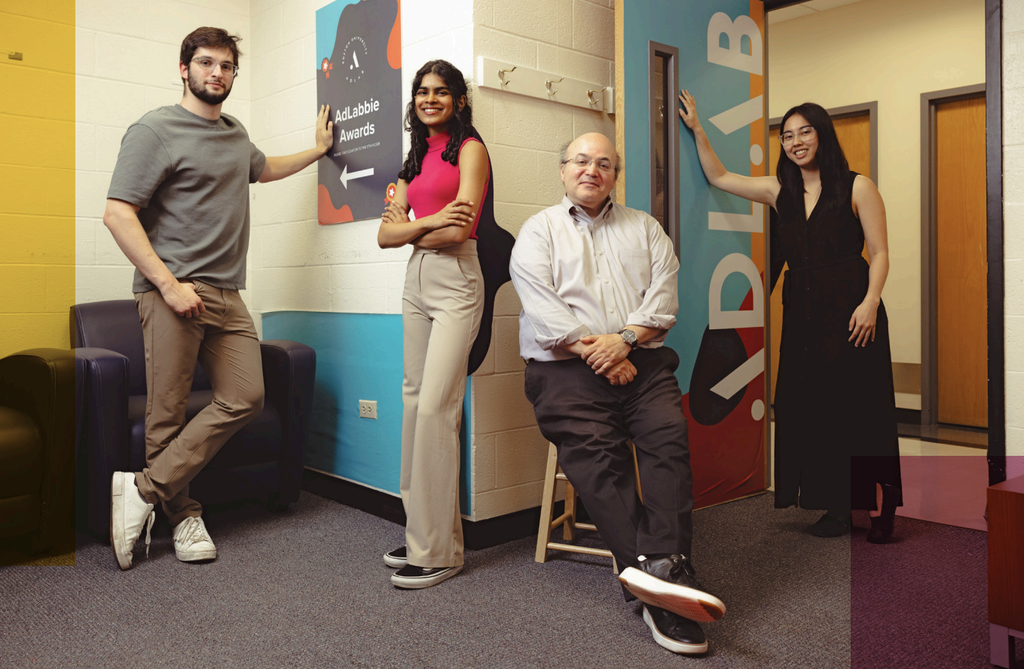
Bob Montgomery (top row, left) and Walter Lubars (middle row, right) created AdLab in 1974 to give students real-world advertising experience. Since then, AdLab has grown into an award-winning agency.
The Agency Experience
For 50 years, the student-run AdLab has created top-notch advertising campaigns for clients around the country
Each Monday afternoon, veteran advertising executive Shawn Zupp supervises an “all agency” meeting. Account executives, art directors, project managers, copywriters and strategists gather to hear updates on projects for clients such as Blue Man Group, WBUR and SiriusXM. Zupp (’95) isn’t overseeing this gathering at a global agency like Ogilvy or BBDO, where he spent much of his 25-year career in account management. He’s in a nondescript classroom, and the team is a group of enthusiastic BU students.
This is AdLab, COM’s student-run ad agency.
AdLab was founded in 1974 by advertising professors Walter Lubars and Bob Montgomery. They wanted to create an opportunity for students to work with real clients, build their portfolios and gain agency experience. Since then, AdLab students have helped hundreds of nonprofits, government agencies and businesses large and small.
“The program was envisioned as a true professional training experience, mimicking the environment and the process and structure of a real advertising agency,” says Zupp, a professor of the practice of advertising and, since 2021, one of AdLab’s faculty advisors along with Chris Lee, a senior lecturer of advertising. “It’s an experiment—hence the lab in the name—in students’ professional advertising selves, as they develop a rigor, a discipline and a sense of, ‘Alright, how do I get things done in advertising?’” One measure of that experiment’s success is that AdLab has inspired a series of COM programs centered on working with real clients, including PRLab, COMLab, Real World Productions and the Emerging Media Masters Collaboratory Project. AdLab is the country’s largest student-run agency. Today, more than 300 students participate in the program each year. As the advertising industry has shifted to more digital work, so has AdLab, with students working on cutting-edge campaigns for social media that are rooted in user experience (UX) and interactive design. Recent graduates have taken jobs at top agencies like MullenLowe, BBDO and Ogilvy or in-house at global brands like ASICS and TJX Companies.
LEARNING ON THE JOB
Any students who are at least in their junior year and who have taken a required introduction to advertising can enroll in AdLab as a semester-long course. Teams typically consist of one account executive, one project manager, two art directors, two copywriters and two strategists. Each team works with their client—about 15 clients participate each semester—to produce an ad campaign that addresses their business needs. Many clients will run the completed campaigns, giving students a professional portfolio before they’ve graduated. Grades are based on performance reviews from the clients and from peer feedback.
“It’s a very different experience for students who are used to assignments and tests,” says Zupp. “AdLab gives students the opportunity to take things out of theory and classroom lessons and put them into real working practice.”

AdLab clients, who have ranged from Boston Symphony Orchestra to Celebrity Cruises, reach out for assistance or are recruited by the program’s student-run executive board. (Students who have completed a semester of the program can later serve on the board, which also helps Zupp and Lee assign the roles for each project.) Clients pay AdLab a fee of $500 for the work produced over the semester, although sometimes production budgets need to be expanded to accommodate more ambitious campaigns.
Zupp says the types of clients AdLab has taken on have evolved throughout its 50-year history. When Lubars and Montgomery started the program, students worked mainly with local nonprofits. In the 1990s, they began taking on local for-profit clients. In the last decade, the program has assisted more national companies.
AdLab’s work has also evolved over the years to keep up with technology. “It was all print work in the late ’70s,” says Zupp. In the past decade, he says, “we obviously became a major developer of social media content, where so much advertising and brand marketing focus is going now.”
Zupp himself was an “AdLabber” in the early ’90s. He recalls sitting in on the all agency meetings and was an account manager on a US Coast Guard campaign to build awareness in the boating community about protecting North Atlantic right whales. The experience solidified his desire to go into account management. “That’s one of the advantages of AdLab: getting to ‘test drive’ the role,” he says.
THE ADLAB EXPERIENCE
In spring 2023, the Wareham, Mass., Gleason Family YMCA turned to AdLab for help with a campaign to boost their summer enrollment. Andrew Rogatinsky and Mei Mei Heipler were members of the team on the account. Rogatinsky (’24), the account executive, was the client’s primary point of contact. “It was constant email communication, weekly meetings answering any questions they might have regarding the team’s progress, and asking the client any questions that the team has,” he says.
Heipler (’24) was one of two art directors on the project. “The key message the client wanted people to take away was that the Y is a place where people can come together, and it helps build community,” she says.
AdLab gives students the opportunity to take things out of theory and classroom lessons and put them into real working practice.
Shawn Zupp
Heipler, her fellow art director, Frank Wu (’23), and the rest of the team brainstormed and came up with a few options to present to their client. The Gleason Family YMCA chose two of the ideas. The first harkened back to the Village People’s 1978 hit single “Y.M.C.A.” and its refrain “It’s fun to stay at the Y.M.C.A.”
“We did different plays on ‘It’s [blank] to stay,’ such as ‘It’s fulfilling to stay at the Y,’” Heipler says. Heipler created graphics for their Facebook page and website. She and Rogatinsky also helped Wu on the second idea, a “Why the Y” video that includes members sharing what they appreciated about the Y.
Both Rogatinsky and Heipler returned to AdLab to serve on its executive board—Heipler as an associate creative director and Rogatinsky as vice president of new business.
For Heipler, the experience helped her sharpen her creative skills. “AdLab emphasizes that we have a common goal of making good work for clients, making something that everyone is proud of and that you can either show in your portfolio or talk about in job interviews,” she says. “It also helped me learn how to take feedback and use it to make my work better.”
Rogatinsky appreciates the unparalleled learning opportunity. “You’re working for a real client, working with a team of eight people, each with their own individual roles. That’s just not something you get in a traditional classroom setting,” he says. “It’s why I decided to apply to join the executive board. I wanted to stay a part of this very unique program that’s one of a kind in the country.”


